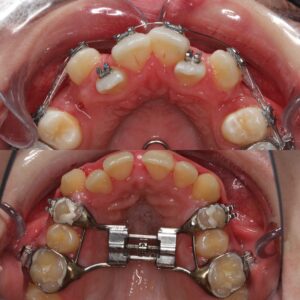In today’s orthodontic landscape, many patients are being introduced to the idea of “airway-friendly orthodontics” — a treatment philosophy that promotes dental arch expansion over extractions. This approach focuses on improving tongue posture, breathing, and facial development by avoiding the removal of teeth.

While the intention behind expansion is often valid, there’s a growing misconception that orthodontic extractions are always harmful — or that they will collapse the face or narrow the smile. The truth is more nuanced.
This post explores the facts, myths, and clinical indications behind both arch expansion and dental extractions — so you can make informed decisions about your treatment and understand space creation in braces treatment.
Arch expansion refers to widening the dental arches to create more room for crowded teeth and improve bite alignment. There are two primary types:
Both techniques can be effective at correcting transverse discrepancies, increasing airway volume, and creating space for mild to moderate crowding.
That said, it’s important to recognize the limitations of expansion — even with MARPE, the maximum arch length gain is typically around 7 mm. In cases of:
…expansion alone isn’t enough — and tooth extractions may still be necessary for a stable, healthy, and aesthetic result.
Tooth extractions are not about cutting corners or damaging facial appearance. In fact, they are often critical in achieving the best possible outcome when:
Even after skeletal expansion, these issues may remain — and in these cases, extractions help bring the teeth into better alignment within the bone, enhance esthetics, and improve stability.
Many patients (and some general dentists) worry that extractions will:
However, none of these outcomes occur when extractions are done properly.
Scientific evidence shows that, when:
…patients get beautiful, functional results — without compromising breathing, facial support, or tongue posture.
In contrast, avoiding extractions when they’re truly needed can result in flared teeth, gum recession, instability, and an unnatural smile arc.
It’s not about choosing one or the other — it’s about choosing what’s right for your unique case.
Expansion is typically indicated when:
Extractions may be needed when:
The goal of orthodontic treatment is to create a healthy, functional, and stable bite — with balanced facial aestheticsand support for airway and oral function.
When performed with the right mechanics and clinical judgment, neither arch expansion nor extractions are harmful. In fact, problems often arise when treatment is based on rigid philosophies instead of individualized, evidence-based care.
If you’re told to “never extract teeth,” ask why — and ensure your treatment plan reflects your unique anatomy and clinical needs, not a blanket trend.
Q: Will extractions make my face look sunken or narrow?
A: No. When done correctly with proper mechanics, facial balance is preserved — often improved.
Q: Can MARPE fix all crowding without extractions?
A: Not always. MARPE can provide up to 7 mm of space. Severe crowding may still require extractions.
Q: Is expansion better than extractions for breathing?
A: It depends on the case. Expansion can improve airway space, but extractions don’t impair breathing when correctly done.
Q: Can adults get skeletal expansion?
A: Yes, with MARPE — a powerful tool for transverse correction in non-growing patients.

I recommend and prescribe orthodontic treatments to my patients as if they were my own family and I value meaningful relationships based on communication, confidence and trust.